|
|
|
Sort Order |
|
|
|
Items / Page
|
|
|
|
|
|
|
| Srl | Item |
| 1 |
ID:
080905
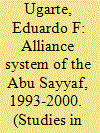

|
|
|
|
|
| Publication |
2008.
|
| Summary/Abstract |
Unsettled conditions on Jolo and Basilan islands in the southwestern Philippines have seriously hampered efforts to obtain information about the Abu Sayyaf. The result has been a continuing ignorance over the most fundamental features of the group. In the attempt to broaden our understanding of its structure, this article examines data drawn from an array of sources in light of the authoritative work of Thomas Kiefer on the traditional Tausug alliance system on Jolo. It argues that the Abu Sayyaf consists of a system of alliance groups of the kind customarily found in Muslim Filipino societies
|
|
|
|
|
|
|
|
|
|
|
|
|
|
|
|
| 2 |
ID:
156914
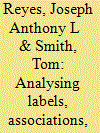

|
|
|
|
|
| Summary/Abstract |
This article investigates Twitter data related to the kidnapping case of two German nationals in the southern region of the Philippines by the Abu Sayyaf Group (ASG). It explores perceptions of the ASG, along with associated organizations and sentiments indicated in the tweets together with statistically significant relationships. Findings revealed that: “Rebel” and “Militant” were the most frequently used labels for the ASG; a majority of the tweets contained sentiments that assess threats such as abduction and kidnapping of hostages; and almost half contained words that indicate negotiation or concession to the demands of the captors. Logistic regression analyses on “Rebel” and “Islamist” revealed positive coefficients for these sentiments used as predictors. This meant that people who assessed threats and expressed sentiments that responders should concede to the captors’ demands were more likely to use the “Rebel” or “Islamist” labels. Rather than the two longstanding dominant narratives of the ASG as terrorists and criminals, the emerging rebel and militant labels suggest a more domestically and politically sensitive Twitter commentary than is represented in the work of the Al-Qaeda-centric paradigm exponents. These findings, along with the complex associated political and policy contexts and implications, are discussed in this article.
|
|
|
|
|
|
|
|
|
|
|
|
|
|
|
|
| 3 |
ID:
112619
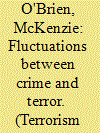

|
|
|
|
|
| Publication |
2012.
|
| Summary/Abstract |
The Abu Sayyaf Group (ASG) in the Philippines is often labeled a terrorist organization, yet there are periods when the group has engaged in far more criminal activity than terrorism. Specifically, this article describes phases in which organized criminal activity far exceeds any terrorist activities before returning to a more predominant focus on terrorism. This study explores reasons for these temporal fluctuations in criminal versus terrorist activity from 1991 thru August 2011, identifying four categories of explanatory factors: leadership, structure, membership and grievances, and linkages to other actors. The study concludes by highlighting some implications for policy, research, and the future of ASG.
|
|
|
|
|
|
|
|
|
|
|
|
|
|
|
|
| 4 |
ID:
099448
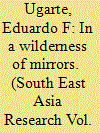

|
|
|
|
|
| Publication |
2010.
|
| Summary/Abstract |
Most media coverage of the 'Abu Sayyaf', an allegedly militant Islamist group or organization in the Philippines, derives ultimately from official sources, but the information provided by such sources has never been subject to scrutiny. To redress the oversight, this paper critically examines official and media accounts of the 'Abu Sayyaf'. Beginning with a survey of media reports from June 2007 to January 2009, it highlights the contradictions uncovered in the sample before accounting for such inconsistencies and other peculiarities in terms of Edward Herman and Noam Chomsky's propaganda model. Applying the model to the performance of the media in the southwestern Philippines, the paper then looks at the factors that render journalists in the region highly dependent on official sources for data, and hence vulnerable to state disinformation, before exploring the framework of presuppositions that influence popular representations of the 'Abu Sayyaf' and the troubles in the zone.
|
|
|
|
|
|
|
|
|
|
|
|
|
|
|
|
| 5 |
ID:
167182
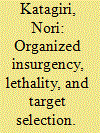

|
|
|
|
|
| Summary/Abstract |
I examine the relationship between organizational stability, lethality, and target selection, and attack method of Southeast Asian insurgency. I do so by comparing the Abu Sayyaf Group (ASG) and Jemaah Islamiyah (JI), using data of their activities between 1994 and 2015. I make two arguments. First, organizationally unstable insurgency groups tend to see their members increase generate more casualties, while stable groups often experience reduction of violence. Second, organizational instability makes it more likely for groups to target civilian populations and business infrastructure than government, military and police forces, and transportation buildings. In contrast, organizational stability has limited explanatory power on its attack methods.
|
|
|
|
|
|
|
|
|
|
|
|
|
|
|
|
| 6 |
ID:
105368
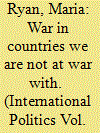

|
|
|
|
|
| Publication |
2011.
|
| Summary/Abstract |
This article examines the origins of the 'Global War on Terror' (GWoT) in peripheral locations; in other words, in countries and regions beyond Iraq and beyond Afghanistan. Although those two countries have remained the 'core' regions of the GWoT, the Bush administration also undertook many other military interventions in countries and regions in ostensibly peripheral locations under the auspices of the 'war on terror'; operations which it referred to in its 2006 Quadrennial Defense Review as 'war in countries we are not at war with'. These include operations in the Horn of Africa, Georgia and the Caspian region, the Philippines and the countries across the Sahara region including Mali, Niger, Chad and Mauritania. This article examines these peripheral theatres in the GWoT and argues that, by its second term, the Bush administration had moved beyond a state-based worldview vis-à-vis terrorism and had truly come to understand it as a transnational problem; a protean network that should be tackled through using Special Operations Forces and unconventional warfare to wage 'war in countries we are not at war with'. The article also considers the extent to which these operations on the 'periphery' were expedient in other ways that often transcended the war on terror because they coincided with the existence of long-standing or newly identified US strategic interests. Finally, the article considers the Obama administration's continuation - and in some cases escalation - of many of the Bush administration's operations in peripheral regions, even as Obama looks to wind down the war in Iraq.
|
|
|
|
|
|
|
|
|
|
|
|
|
|
|
|
| 7 |
ID:
106784
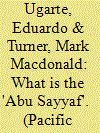

|
|
|
|
|
| Publication |
2011.
|
| Summary/Abstract |
Official sources and the media often represent the 'Abu Sayyaf' as a militant Islamist group or organization responsible for most atrocities in the southwestern Philippines. Frequently implicit within such representations is the assumption that the reported terrorist/bandit entity possesses the basic features of a conventional organization. Yet this assumption is irreconcilable with the many available descriptions of the armed groups labelled 'Abu Sayyaf' since the early 1990s. To resolve this incongruity, the article examines reigning perceptions of the 'Abu Sayyaf' in light of organization theory and network analysis. It begins with a summary of conventional definitions of organizations, before identifying alternative conceptual aids useful for understanding the phenomenon known as the 'Abu Sayyaf'. It then teases out the presuppositions that underpin popular views of the phenomenon through a sample of early military and rebel depictions. It compares those presuppositions with the structural features of the armed coalitions involved in two mass kidnappings attributed to the 'Abu Sayyaf'. The remainder of the article analyzes the 'Abu Sayyaf' in terms of 'dark' or illegal networks and supporting concepts from organization theory. To dispel the confusion surrounding the phenomenon, the article reviews the genealogy of the 'Abu Sayyaf' label in order to reveal the circumstances that gave birth to the perception of it as being a coherent group or organization. The article concludes with a brief ideal-typical interpretation of the covert networks in which the armed groups branded 'Abu Sayyaf' have been and continue to be enmeshed.
|
|
|
|
|
|
|
|
|
|
|
|
|
|
|
|
|
|
|
|
|